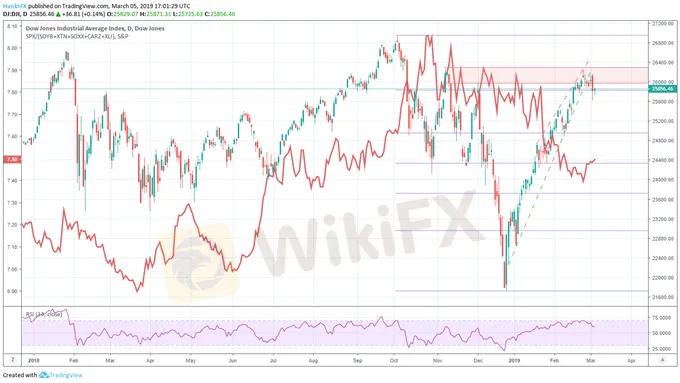简体中文
繁體中文
English
Pусский
日本語
ภาษาไทย
Tiếng Việt
Bahasa Indonesia
Español
हिन्दी
Filippiiniläinen
Français
Deutsch
Português
Türkçe
한국어
العربية
Dow Jones Pressured by Export-Sensitive Sectors on China GDP
Abstract:The five largest export sectors to China may see their underlying shares weigh on the broader market after China lowered growth forecasts.
Stock Market Talking Points:
Aircraft, automotive, manufacturing, semiconductor and agricultural sectors have lagged the S&P 500 in recent month
Despite trade optimism between the US and China, the sectors have been pressured as Chinas growth is set to slow
A trade war breakthrough could spark a rebound in companies sensitive to Chinese demand
See how IG clients are positioned on the Dow Jones, Crude oil and the US Dollar with our free IG Client Sentiment Data.
Export-heavy sectors in the Dow Jones may remain pressured in the coming days as markets come to terms with lower Chinese GDP forecasts. On Tuesday, Chinese Premier Li Keqiang said the Chinese government will aim for the economy to grow in a range of 6% to 6.5% in 2019, compared to last years 6.5% goal. Despite progress toward a US-China trade war deal and significant optimism regarding the talks in markets, materially lower GDP will likely constitute a reevaluation of earnings to be garnered in sectors that rely on Chinese exports.
Read up on A Brief History of Trade Wars for a primer on economic conflicts of the past.
The sectors which export the most to China: aircraft, machinery, agriculture, automotive and microchips account for roughly $67 billion in annual exports according to the Office of the United States Trade Representative. Together, the export totals from the five sectors make up approximately 51% of the $129.9 billion in total US exports to China. To gauge the impact of lowered GDP forecasts on US equities, the aggregated ETF prices of the largest fund from each sector can be compared to the S&P 500.
Dow Jones Price Chart: Daily Time Frame (January 2018 – March 2019) (Chart 1)

Dow Jones Price Chart overlaid with ratio of S&P 500 to SOYB, XLI, XTN, SOXX, CARZ ETF
While the index is imperfect in capturing all export components, it does serve to provide a general overview of the performance of companies sensitive to Chinese growth and imports. Major names in the underlying funds include Boeing, Ford, Caterpillar, Micron and General Motors. Therefore, their impact on the broader indices of the Dow Jones and the S&P 500 can be substantial.
Looking to take your trading to the next level? Check out our free Advanced Trading Guides.
Moving forward, the underlying shares and sectors may be a source of volatility in the US equity market as traders and investors iron out the revenue implications of slower Chinese growth. Conversely, a trade-war breakthrough could serve to buoy the threatened sectors.
A deal could also propel the agricultural sector, most notably soybeans (SOYB ETF), to rebound to pre-trade war levels. Such a rebound would likely make meaningful progress in driving the ratio of the funds lower versus the S&P 500, recapturing some of the lost ground over the last nine months and offering an opportunity for the sector to outperform benchmarks.
--Written by Peter Hanks, Junior Analyst for DailyFX.com
Contact and follow Peter on Twitter @PeterHanksFX
Read more: Stock Market Fund Inflows Return as S&P 500 Hits Technical Resistance
DailyFX forecasts on a variety of currencies such as the US Dollar or the Euro are available from the DailyFX Trading Guides page. If you‘re looking to improve your trading approach, check out Traits of Successful Traders. And if you’re looking for an introductory primer to the Forex market, check out our New to FX Guide.
Disclaimer:
The views in this article only represent the author's personal views, and do not constitute investment advice on this platform. This platform does not guarantee the accuracy, completeness and timeliness of the information in the article, and will not be liable for any loss caused by the use of or reliance on the information in the article.
Read more

Dow Jones, DAX 30, FTSE 100, S&P 500 Forecasts for the Week
The Dow Jones, DAX 30, FTSE 100 and S&P 500 may look to melt higher ahead of a monumental Fed meeting on Wednesday, but will past peaks look to rebuke a continuation higher?

Australian Dollar Outlook: AUD/USD & AUD/JPY Eye RBA Meeting
The September RBA meeting is now 1-week away which sets AUDUSD and AUDJPY back in the spotlight. Where might the Australian Dollar head next?

S&P 500 Price Targets: SPX Consolidation Levels – Technical Trade Outlook
The S&P 500 remains within a broad consolidation level just below a key pivot zone weve been tracking for weeks. These are the levels that matter on the SPX500 charts.

S&P 500, US Dollar, Gold, Emerging Market Outlook: What Happens After US Yield Curve Inverts?
S&P 500, US Dollar, Gold, Emerging Market Outlook: What Happens After US Yield Curve Inverts?
WikiFX Broker
Latest News
Why Even the Highly Educated Fall Victim to Investment Scams?
Warning Against Globalmarketsbull & Cryptclubmarket
BSP Shuts Down Uno Forex Over Serious AML Violations
ACY Securities Expands Global Footprint with South Africa Acquisition
Tokyo Police Arrest 4 for Unregistered FX Trading Scheme
Rupee gains against Euro
Axi Bids AUD 52M to Acquire Low-Cost Broker SelfWealth, Outbidding Competitor Bell Financial
Crypto Influencer's Body Found Months After Kidnapping
US Regulators Tighten Oversight on Bank Anti-Money Laundering Efforts
Doo Group Expands Its Operations with CySEC License
Currency Calculator


